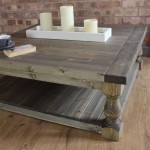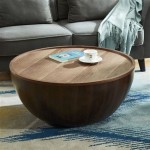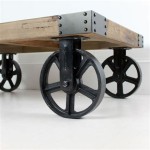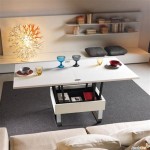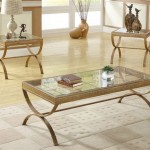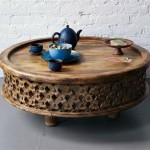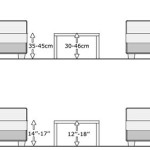Small Living Room Side Table Ideas
The living room, often the central hub of a home, requires careful consideration when it comes to furniture selection. Space optimization is paramount, particularly in smaller living rooms. The side table, a seemingly minor element, plays a crucial role in both functionality and aesthetics. Choosing the right side table can significantly enhance the utility and visual appeal of a compact living space.
A side table provides a convenient surface for lamps, beverages, books, and other essential items. It can also contribute to the overall décor, complementing the existing furniture and adding a touch of personal style. However, in a small living room, a bulky or poorly chosen side table can easily overwhelm the space, making it feel cramped and cluttered. Therefore, careful planning and consideration of various factors are essential when selecting side tables for smaller living rooms. This article explores diverse small living room side table ideas, emphasizing practical considerations and design principles.
Multifunctional Side Tables: Optimizing Space and Utility
In a small living room, every piece of furniture should serve multiple purposes. Multifunctional side tables are an excellent way to maximize space and utility. These tables often incorporate features such as built-in storage, adjustable heights, or foldable designs, making them highly adaptable to various needs.
One popular option is a side table with a built-in drawer or cabinet. This provides concealed storage for remote controls, magazines, or other small items, helping to keep the living room tidy and organized. Some models even feature open shelves, offering a convenient display area for books or decorative objects. The concealed storage element is particularly beneficial in maintaining a minimalist aesthetic, as it reduces visible clutter.
Another space-saving design is the nesting side table set. These tables consist of two or three smaller tables that fit neatly inside each other. When needed, they can be pulled out and used as separate surfaces. When not in use, they can be nested together, taking up minimal floor space. This versatility makes nesting tables ideal for accommodating guests or adapting to changing needs.
Adjustable-height side tables offer another level of functionality. These tables can be raised or lowered to suit different activities, such as working on a laptop or enjoying a meal while watching television. Some models even feature tilting tabletops, providing an ergonomic surface for reading or writing. The adjustable height feature makes them versatile for different seating arrangements and individual preferences.
Foldable side tables are an excellent choice for those who need a temporary surface that can be easily stored away. These tables can be quickly folded and stored when not in use, freeing up valuable floor space. They are particularly useful in small apartments or living rooms where space is at a premium.
When selecting multifunctional side tables, it is crucial to consider the quality of the materials and construction. Look for tables made from durable materials that can withstand regular use. Also, pay attention to the design and aesthetics, ensuring that the tables complement the overall décor of the living room.
Choosing the Right Shape and Size: Proportion and Harmony
The shape and size of a side table can significantly impact the overall feel of a small living room. Selecting the right proportions is essential for creating a harmonious and balanced space. Avoid bulky or oversized tables that can overwhelm the room. Instead, opt for smaller, more streamlined designs that fit comfortably alongside your existing furniture.
Round side tables are often a good choice for small living rooms. Their curved edges create a softer, more inviting feel, and they can help to break up the straight lines of other furniture. Round tables also tend to take up less visual space than rectangular or square tables, making them a good option for tight corners or narrow spaces.
Square side tables are another popular choice, offering a clean and modern look. They are particularly well-suited for rooms with a contemporary design aesthetic. However, it is essential to choose a square table that is not too large, as it can easily dominate the space. Consider a smaller square table with rounded edges for a softer look.
Rectangular side tables can also work well in small living rooms, especially when placed alongside a sofa or armchair. Choose a rectangular table that is narrow and long, rather than wide and short. This will help to maximize surface area while minimizing the amount of floor space it occupies.
When determining the ideal size of a side table, consider the height of the surrounding furniture. The table should be approximately the same height as the arm of the sofa or armchair, allowing for easy access to items placed on the table. Avoid tables that are significantly higher or lower than the surrounding furniture, as this can create an awkward and unbalanced look.
Consider also the scale of the room itself. In a very small living room, even a modestly sized side table might appear disproportionately large. Opt for minimalist designs that are visually light and airy. Glass or acrylic tables can be particularly effective in creating a sense of spaciousness.
Material and Style Considerations: Complementing the Décor
The material and style of a side table should complement the overall décor of the living room. Consider the existing color palette, furniture styles, and architectural features when making your selection. Choosing a side table that blends seamlessly with the existing design will create a cohesive and harmonious space.
Wooden side tables are a classic and versatile choice, suitable for a wide range of decorating styles. Different types of wood offer different looks, from the warm and rustic tones of oak to the sleek and modern feel of walnut. Consider the grain and finish of the wood, ensuring that it complements the other wooden elements in the room.
Metal side tables offer a more contemporary and industrial aesthetic. They are often made from materials such as steel, iron, or aluminum, and can be finished in a variety of colors and textures. Metal tables are particularly well-suited for modern or minimalist living rooms.
Glass side tables are a great choice for small living rooms, as they create a sense of spaciousness and lightness. Clear glass tables seem to disappear into the background, allowing other elements of the décor to take center stage. Smoked or tinted glass tables can add a touch of sophistication and drama.
Acrylic side tables are another option for those seeking a modern and transparent look. Acrylic is a durable and lightweight material that can be molded into a variety of shapes and sizes. It is also resistant to scratches and stains, making it a practical choice for high-traffic areas.
When choosing the style of a side table, consider the overall theme of the living room. For a traditional living room, opt for a side table with classic lines and ornate details. For a modern living room, choose a sleek and minimalist design with clean lines. For a bohemian living room, consider a side table with a more eclectic and artistic flair.
The color of the side table should also complement the existing color palette of the living room. Neutral colors such as white, black, gray, and beige are always a safe bet, as they can easily blend with a variety of decorating styles. However, don't be afraid to introduce a pop of color with a brightly colored side table, especially in a neutral-toned room. The color can echo an accent color used elsewhere in the room to create a cohesive design.
In addition to the material, style, and color, consider also the texture of the side table. A side table with a textured surface can add visual interest and depth to a room. Consider a side table with a woven rattan top, a hammered metal finish, or a distressed wood surface.
By carefully considering the material and style of your side tables, you can create a cohesive and harmonious living room that reflects your personal taste and style.
Choosing the right side tables for a small living room requires careful consideration of various factors, including functionality, size, shape, material, and style. By opting for multifunctional designs, selecting the appropriate proportions, and complementing the overall décor, it is possible to enhance both the utility and aesthetics of a compact living space. These considerations contribute to a living room that feels both spacious and stylish, optimizing the use of available space while creating a welcoming and comfortable environment.

Side Table Decor Ideas To Make Your Home Look Amazing
:strip_icc()/cdn.cliqueinc.com__cache__posts__191613__small-living-room-ideas-191613-1526001981902-main.700x0c-ab3bbf79e5664b22b0a1973abcd3a11f.jpg?strip=all)
35 Designer Approved Small Living Room Ideas

Small Living Room Ideas Decorating Tips Coastwood Furniture

4 Need To Know Tips For Decorating A Small Space

Small Living Room Decor Ideas And Inspiration For 2025

Side Table Design For The Living Room Top Ideas Your Home

Home Decor 101 How To Decorate End Tables The Turquoise

Cristian Marble Side Table Finn Avenue
.jpg?strip=all)
Styling Two Matching Sofa End Tables Dream Green Diy

33 Simple And Stunning Ideas For Side Table Décor
Related Posts

